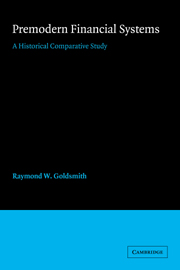Book contents
- Frontmatter
- Contents
- List of tables
- Preface
- 1 Introduction
- 2 The financial systems of the ancient Near East
- 3 The financial system of Periclean Athens
- 4 The financial system of Augustan Rome
- 5 The financial system of the early Abbasid caliphate
- 6 The financial system of the Ottoman Empire at the death of Suleiman I
- 7 The financial system of Mughal India at the death of Akbar
- 8 The financial system of early Tokugawa Japan
- 9 The financial system of Medici Florence
- 10 The financial system of Elizabethan England
- 11 The financial system of the United Provinces at the Peace of Münster
- 12 Similarities and differences
- Notes
- Bibliography
- Index
8 - The financial system of early Tokugawa Japan
Published online by Cambridge University Press: 05 March 2012
- Frontmatter
- Contents
- List of tables
- Preface
- 1 Introduction
- 2 The financial systems of the ancient Near East
- 3 The financial system of Periclean Athens
- 4 The financial system of Augustan Rome
- 5 The financial system of the early Abbasid caliphate
- 6 The financial system of the Ottoman Empire at the death of Suleiman I
- 7 The financial system of Mughal India at the death of Akbar
- 8 The financial system of early Tokugawa Japan
- 9 The financial system of Medici Florence
- 10 The financial system of Elizabethan England
- 11 The financial system of the United Provinces at the Peace of Münster
- 12 Similarities and differences
- Notes
- Bibliography
- Index
Summary
In any analysis of the economy of early Tokugawa Japan under its first three shoguns (Ieyasu, Hidetada, and Iemitsu) from 1600 to 1651, and hence of its financial structure, half a dozen characteristics of Japan during that period, and indeed until the mid-nineteenth century, must be kept in mind.
By seventeenth century standards Japan was in terms of population a large and rapidly growing country. With about 20 million inhabitants at the beginning and about 30 million at the end of the century, Japan was larger than any European country – it had, for example, slightly more inhabitants than France and about five times the population of England and Wales – and outside of Europe was surpassed only by the Ming Empire of China and by Mughal India.
Tokugawa Japan was a more highly centralized and controlled country than any in Europe and from 1615 on enjoyed external and internal peace.
The description of Japan's political structure as bakuhan indicates the coexistence of territories directly owned by the shogun, which covered about one-fourth of the country, with about 250 fiefs awarded by the shogun to vassals (daimyo) who had substantial freedom of action within their fiefs, but in fact were not much more than governors serving at the shogun's pleasure and under his orders.
[…]
- Type
- Chapter
- Information
- Premodern Financial SystemsA Historical Comparative Study, pp. 123 - 144Publisher: Cambridge University PressPrint publication year: 1987

